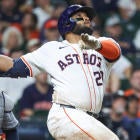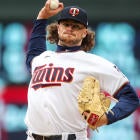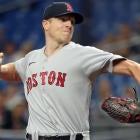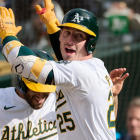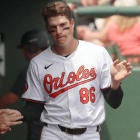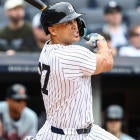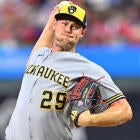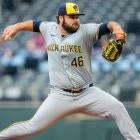Maybe Oscar Taveras will be up June 4 for the start of a seven-game stretch in American League parks.
Maybe Maikel Franco will be up even sooner than that.
Granted, Franco is no Taveras, who I covered in great detail last week, but he has the added advantage of playing one of the most troublesome positions in Fantasy: third base.
And he profiles as an impact bat himself.
|
|
||
| Player | Own % | |
| 1. | Gregory Polanco, OF, PIT | 75 |
| 2. | Oscar Taveras, OF, STL | 70 |
| 3. | Jon Singleton, 1B, HOU | 49 |
| 4. | Archie Bradley, SP, ARI | 45 |
| 5. | Javier Baez, SS, CHC | 45 |
| 6. | Danny Salazar, SP, CLE | 44 |
| 7. | Noah Syndergaard, SP, NYM | 39 |
| 8. | Byron Buxton, OF, MIN | 35 |
| 9. | Andrew Heaney, SP, MIA | 31 |
| 10. | Kris Bryant, 3B, CHC | 30 |
Wait, no, don't look at his 2014 numbers. As with Allen Craig and Adrian Beltre, they'll only throw you off the scent. Franco got off to a cold start, possibly due to cold weather, but as with Craig and Beltre, his overall numbers conceal the full extent of his resurgence. In May, he's batting .287 with three home runs and an .821 OPS.
And there's more where that come from.
The line that sets everyone's heart aflutter is the one he put up between two stops last year, batting .320 with 31 home runs and a .926 in a season split almost evenly between high Class A Clearwater and Double-A Reading. The jump to Double-A is widely considered the toughest for a minor-leaguer, but Franco made it look easy with a .339 batting average.
Of course, he did it playing half his games in an extreme hitter's park, but that doesn't account for him striking out just 70 times in 541 at-bats -- a rate rarely seen for a player with his power potential.
Which is almost exactly what I said about Taveras last week.
Now obviously, Taveras is a better prospect than Franco. He's been in the discussion for best in baseball the last two years. He's thrived at every level without any real letup while Franco has only last year going for him. But if Taveras' exceptional contact rate helps distinguish him from other minor-league mashers, it should also help distinguish Franco, regardless of what he's doing at Triple-A at the moment.
Because ultimately, what Franco does at Triple-A counts only for how quickly it gets him to the big leagues, and with the recent injury to Cody Asche, what he's done so far may prove to be enough.
The timing is less than perfect. When Asche went down with a strained hamstring, Franco was sidelined by an upper respiratory illness. He has since returned but is just 5 for 32 (.156) over his last nine games. Most likely, it's a bump in the road -- the kind of slump readily dismissed for a proven major leaguer -- but so as not to set him up for failure, manager Ryne Sandberg told the Philadelphia Daily News the Phillies won't promote Franco until he's in a groove at the plate.
So then, could he arrive at some point during Asche's DL stint?
"He could. It's possible," general manager Ruben Amaro Jr. said. "Just to get him hot at the point where he's confident and feeling good about his swing and being in a good rhythm. There's no reason to bring a guy up who's not swinging the bat very well."
I get the sense from those comments that if not for his recent illness and this little cold spell, Franco might already be in the big leagues. I also get the sense that if he goes 4 for 5 with two home runs tonight, he'll be up tomorrow.
So now, the pressure is on. Though a hamstring strain could sideline a player for anywhere from two weeks to two months, Asche's seems to be of lesser severity, which gives Franco about 10 games to take advantage of this opportunity. Personally, I think the idea of him winning Amaro and Sandberg over in that short period of time is a bit nutty, but if they leave open the possibility, who am I to argue?
And if they leave open the possibility, I'm inclined to take it seriously, because while Franco may not be Taveras, he's capable of meeting a need that, in some leagues, the waiver wire can't. He could be an impact third baseman.
Of course, he could also be a waste of everyone's time at age 21 and earn a one-way ticket back to Lehigh Valley, but that's the risk you run with any prospect. If you can afford the bench spot and know you won't have a better shot at respectability at the position, why not take the chance?
Whether this injury opens the door for him or not, by simply acknowledging the possibility, Amaro and Sandberg revealed Franco is in their short-term plans. And a healthy Asche, with his .258 batting average and .771 OPS, isn't enough to block him. He may slow him down if he beats him to the active roster, but barring a complete collapse at Triple-A, Franco is the Phillies' starting third baseman come the second half.
That puts him up there with Jon Singleton in terms of stashability.
|
|
If you have listened to our podcast, you know I've developed a reputation for butchering names. It's how the "Hurc Love" song got its roots and spawned the segment on the podcast called "Hurc'd on Phonics."
Thankfully, this is written content and all I have to worry about is spelling because this next name is a doozy -- Odrisamer Despaigne. However, it's a name I better start working on pronouncing because it looks like the Padres pitching prospect will soon be gracing the majors with his presence. Luckily, the Padres were nice enough to provide a phonetic breakdown of his name -- pronounced O-DREE-SA-MEHR DES-PAWN-NYAY -- so maybe there is hope for me after all.
Anyway, you are probably wondering who is Despaigne? The 6-0, 196-pound Cuban hurler was signed to a minor-league contract May 2 by San Diego. The 27-year-old right-hander played eight pro seasons in Cuba, amassing a 61-43 record with a 3.55 ERA, 684 strikeouts and 390 walks in 213 appearances (957 1/3 innings).
Why do you need to know about Despaigne? Well in the short time he's been in this country, he's already earned a promotion to Triple-A El Paso after just two starts for Double-A San Antonio. He posted a 1.17 ERA and 1.17 WHIP, while allowing one run on four hits and five walks in 7 2/3 innings for San Antonio. He also struck out 12.
Last week, Padres general manager Josh Byrnes said Despaigne could be a factor for the major-league club soon, according U-T San Diego. His brief pit stop at San Antonio is evidence of that, so it sent me scrambling to the Internet to find a scouting report on the Cuban pitcher.
What I've gathered is that the scouts are torn between Despaigne ending up as a starter or reliever. During a 90-minute workout in February, Despaigne had a 35-pitch throwing session, which featured cut fastballs, changeups and sliders. He hovered between 92-94 mph and topped out at 95 mph.
The one thing that constantly comes up is Despaigne's deceptive delivery. The scouts consider Despaigne's repertoire to be average, but they say he's successful because his ability to change arm slots and angles. Heck, even Despaigne knows that is his strength.
"I hope I can have half the career that [Orlando Hernandez] had, because he's been my idol since I was a child, but like him, I throw from a lot of different angles," Despaigne said, per MLB.com.
So what should we expect? It seems as though the Padres are stretching out Despaigne to start. With Josh Johnson out for the season, and Andrew Cashner and Robbie Erlin on the disabled list, the Padres are showing the need to build rotation depth and quickly.
The El Paso rotation features Despaigne, Matthew Wisler, Keyvius Sampson and Burch Smith (injured), and they soon might be joined by Casey Kelly, who is working his way back from Tommy John surgery. But if the Padres were confident in any of those arms, then there might not be a need to rush Despaigne.
Despaigne is an intriguing enough prospect because of the way he's being ushered through the minors. It would be nice if he has the kind of impact Cuban imports Jose Abreu, Yoenis Cespedes and Yasiel Puig have had on offense, but those are lofty expectations, especially since the scouts aren't sure if Despaigne has a future as starter because of his fringy arsenal. But his strength is his unique delivery, which might suit him well in the majors.
I would definitely consider stashing Despaigne in dynasty and NL-only leagues. However, with plenty of talent left on waivers in mixed leagues, unless you are in a very deep format, then it might not be worth stashing the fast riser.
Kyle Crick, SP, Giants
Affiliate: Double-A
Richmond
2014 stats: 2-1, 4.08 ERA, 1.71 WHIP, 16 runs (13
earned), 25 hits, 24 walks, zero home runs, 31 strikeouts and three wild
pitches in eight starts (28 2/3 innings)
You might not know it by
looking at his 2014 stats, but Crick came into the season as the Giants'
top-ranked prospect by Baseball America and MLB.com. Either that
speaks to how poor the Giants' farm system is or how good everyone
thinks Crick can be despite having serious command problems. Aside from
his 1.71 WHIP this season, he is walking 7.5 batters per nine innings.
It's not like this is a new issue because Crick is walking 5.8 batters
per nine over his career. Though, Crick is held in such high regard
because of his live arm. The scouts talk about him being effective
despite poor command because of his mid-90s fastball that he complements
nicely with a slider and curveball. Still, you have to be concerned
about the command problems because more advanced hitters capitalize on
mistakes, and they already starting to do so against the 2011
first-round pick. Crick got away with a high walk rate in the low
minors, but it's catching up to him now. Just look at how former Giants
farmhand Zack Wheeler is struggling to
find consistency at the major-league level as his walk rate sits above
4.0.
Michael Lorenzen, SP, Reds
Affiliate: Double-A
Pensacola
2014 stats: 2-3, 1.99 ERA, 1.09 WHIP, 17 runs (13
earned), 46 hits, two home runs, 18 walks, 40 strikeouts, three hit
batters and two wild pitches in 10 starts (58 2/3 innings)
Whoever in
the Reds' organization is responsible for finding and developing
starting pitchers deserves a serious raise. The major-league rotation is
already full of homegrown arms -- Johnny Cueto,
Mike Leake, Homer Bailey, Tony Cingrani -- and
there is a ton more talent in the pipeline. We've already featured Robert Stephenson and Ben Lively, who
are both dominating in the minors. Now, it's Lorenzen's turn, and he's
been equally as impressive this season. The former college outfielder is
in his first full season as a starter and making the Reds look good for
using a first-round pick on him last year despite the right-hander only
pitching in relief at Cal State Fullerton. But the team felt he had
enough athleticism and a live arm to make the transition to starter, and
thus far it's paying off. The scouts talk about Lorenzen having to
refine his secondary pitches if he wants to remain a starter, but even
if that doesn't happen, they project him to be a late-inning reliever or
closer because his fastball is a plus-plus pitch and his slurve (a
slider thrown as a curve) also projects as a better-than-average pitch.
Kevin Plawecki, C, Mets
Affiliate: Double-A
Binghamton
2014 stats: .336/.371/.507/.878, four home runs, 12
doubles, 18 runs, 25 RBI, seven walks and 18 strikeouts in 35 games
I'm
sure some Mets fans would like to see Plawecki in The Big Apple right
now given Travis d'Arnaud's struggles. However, it's not time to give up
on d'Arnaud, who has logged just 62 games at the major-league level. He
was an elite talent in the minors, and hopefully in time that will show
in the majors. In the meantime, it's worth talking about Plawecki, who
is making headlines down on the farm. Plawecki has displayed enough
power in the minors to post some interesting slugging percentages, but
he's not a home run hitter. He's more of a contact and doubles hitter.
His real strength is his plate discipline. Plawecki struck out just 29
times in three seasons in college and has as nearly as many walks (74)
as he does strikeouts (95) as a pro. He also has a .375 on-base
percentage. The scouts feels Plawecki is good enough offensively and
defensively to project as a major-league starting catcher, despite
moderate home run power. At worst, they feel he can be a part-time
catcher and first baseman.
J.P. Crawford , SS, Phillies
Affiliate: Class
A Lakewood
2014 stats: .344/.435/.488/.923, three home runs,
14 doubles, 15 RBI, 27 runs, 25 walks, 24 strikeouts and nine stolen
bases in 42 games
When the Phillies selected Crawford with the 16th
pick in the 2013 MLB draft, there were no issues about his defense but a
few concerns about his offense. Well, Crawford is doing a great job
silencing his critics. After winning the Rookie-level Gulf Coast League
batting title in 2013, Crawford is off to a roaring start in 2014.
Through 95 pro games, he's batting .324 with a .419 on-base percentage,
.439 slugging percentage and .858 OPS. The scouts appeared confident
Crawford could hit for average and remain hopeful he will hit for power
as he adds bulk. Well, the 19-year-old prospect is already starting to
show signs of improving power, as he has a .488 slugging percentage
through 42 games for Lakewood. Even more impressive is his plate
discipline, as Crawford has 57 walks to 59 strikeouts in his career.
Even though he is a high-school draftee, Crawford appears as though he
could move quickly through the minors and be the eventual heir apparent
at shortstop to Jimmy Rollins, who could
be a free agent after the 2014 season if his $11 million vesting option
for 2015 doesn't kick in.
Trey Ball, SP, Red Sox
Affiliate: Class A
Greenville
2014 stats: 1-4, 8.38 ERA, 2.17 WHIP, 19 runs (18
earned), 33 hits, two home runs, nine walks, 12 strikeouts and two hit
batters in five starts (19 1/3 innings)
In Baseball America's
prospect profile on Ball, they have one talent evaluator quoted as
saying the left-handed pitching prospect has a "serious wow factor." I
agree, as in "wow" I can't believe how bad he's been as a pro. Granted,
Ball has logged just 10 starts (26 1/3 innings) in his young career, but
he is 1-5 with a 7.86 ERA and 2.20 WHIP. Not exactly numbers you want to
see from a top-10 draft pick, which the Red Sox made him in 2013
(seventh overall). It's still very early in Ball's career, so maybe we
can't put a lot of stock into his numbers. It's just that they really
stand out and not in a positive light. Ball entered the draft last
season as arguably the top two-way prospect, but he was drafted as a
pitcher after the scouts felt he could develop three above-average
pitches (fastball, changeup, curveball). Some scouts feel Ball might
develop into a frontline starter, but right now it's not looking that
way. If worse comes to worst, the Red Sox probably feel they could just
convert Ball back to an outfielder in the even pitching doesn't pan out
since he's athletic enough to make the transition.













